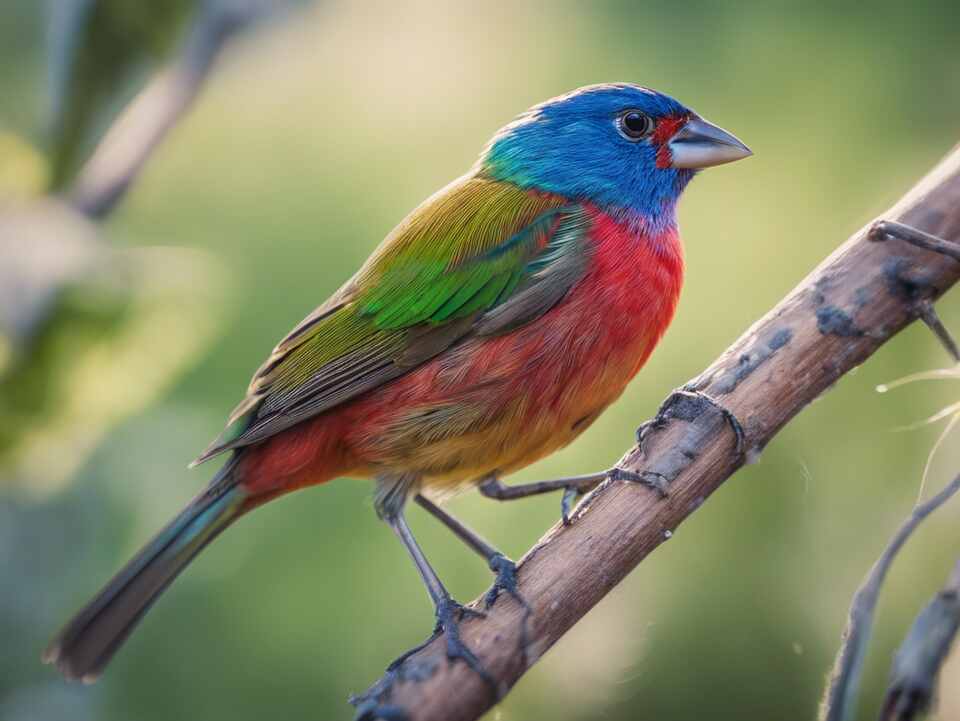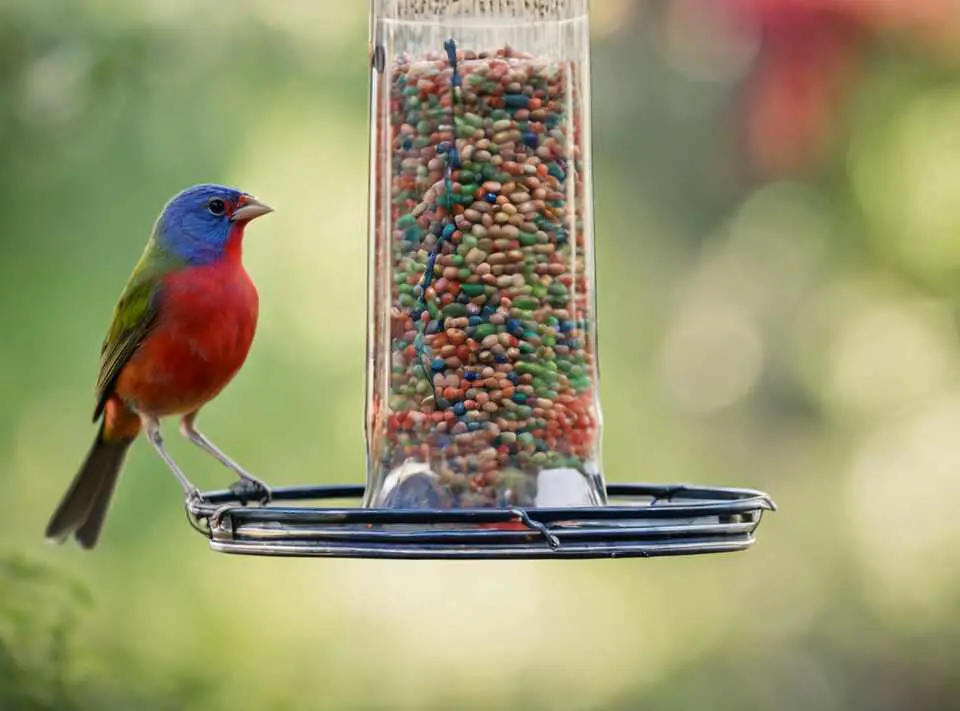Welcome to a journey into the vibrant world of one of nature’s most dazzling treasures. With its breathtaking array of hues and captivating presence, the Painted Bunting stands as a testament to the artistry of evolution.
In this exploration, we’ll unravel the mysteries behind its vivid plumage, dive into its intriguing behaviors, and uncover the significance of its presence in our ecosystems.
Join us as we unravel the kaleidoscope of colors that adorn the wings of this enchanting bird, and discover the wonders that lie within.
Table of Contents
- 1 Discovering the Vibrant Plumage of the Painted Bunting
- 2 The Fascinating Behaviors and Habitats of the Painted Bunting
- 2.1 The Vibrant and Captivating Painted Bunting
- 2.2 Exploring the Captivating Appearance of the Painted Bunting
- 2.3 Exploring the Habitats and Breeding Habits of the Painted Bunting
- 2.4 Unraveling the Fascinating Foraging Behaviors of the Painted Bunting
- 2.5 Uncovering the Migratory Patterns of the Painted Bunting
- 2.6 Appreciating the Conservation Efforts for the Painted Bunting
- 3 Conclusion
- 4 Author
Discovering the Vibrant Plumage of the Painted Bunting
A Vibrant Splash of Color: Exploring the Painted Bunting
The Painted Bunting is a truly captivating bird, known for its dazzling and vibrant plumage that seems almost unreal. This small songbird, native to the southeastern United States and parts of Mexico, is a true delight for birdwatchers and nature enthusiasts alike. With its striking combination of blues, greens, reds, and oranges, the Painted Bunting is a feast for the eyes and a testament to the incredible diversity of the natural world.
The Allure of the Painted Bunting
One of the most striking features of the Painted Bunting is its remarkable color palette. The male birds are particularly stunning, with a deep blue head, bright green back, and a stunning combination of red, orange, and yellow on their underparts. The females, while less vibrant, are still quite beautiful, with a more muted palette of greens and browns. This striking appearance is not just for show – the Painted Bunting’s plumage serves an important function in courtship and territoriality, helping the birds attract mates and defend their turf.
Habitat and Behavior
The Painted Bunting is found primarily in the southeastern United States, with its range extending from Texas to Florida and as far north as Missouri and North Carolina. These birds prefer open, brushy habitats, such as woodland edges, gardens, and fields, where they can find ample food sources and nesting sites. During the breeding season, the males are particularly territorial, often engaging in fierce displays and vocalizations to ward off rivals and attract females.
Feeding Habits and Diet
The Painted Bunting is an omnivorous bird, feeding on a variety of seeds, insects, and even small fruits. They are particularly fond of millet, sunflower seeds, and other small grains, which they often forage for on the ground or in low-lying vegetation. Their diet helps them to maintain their vibrant plumage, as the carotenoids and other pigments found in their food contribute to the development of their stunning colors.
Conservation Efforts
While the Painted Bunting is not currently considered threatened or endangered, there are some concerns about its long-term conservation status. Habitat loss and fragmentation, as well as the use of pesticides and other chemicals, can have a negative impact on Painted Bunting populations. Conservation organizations and birdwatchers alike are working to raise awareness about the importance of protecting these beautiful birds and their habitats.
Appreciating the Painted Bunting
For those who are lucky enough to catch a glimpse of the Painted Bunting, the experience is one that is truly unforgettable. The sheer vibrancy and beauty of this bird’s plumage is a testament to the incredible diversity and wonder of the natural world. Whether you are a seasoned birdwatcher or a casual nature enthusiast, the Painted Bunting is a bird that is sure to captivate and inspire.
The Fascinating Behaviors and Habitats of the Painted Bunting
The Vibrant and Captivating Painted Bunting
The painted bunting, scientifically known as Passerina ciris, is a small, brightly-colored songbird that has captured the hearts of birdwatchers and nature enthusiasts alike. This stunning species, with its vibrant plumage and unique behavioral patterns, is a true gem of the avian world.
Exploring the Captivating Appearance of the Painted Bunting
The painted bunting is renowned for its striking appearance, which has earned it the nickname “the most beautiful bird in North America.” The male of the species boasts an array of vivid colors, including a bright blue head, a red chest, and a mix of green, yellow, and indigo on its back and wings. The female, on the other hand, sports a more subdued plumage, typically featuring shades of green and brown. This remarkable color combination makes the painted bunting a true visual delight, and a highly sought-after target for birdwatchers and photographers alike.
Exploring the Habitats and Breeding Habits of the Painted Bunting
Painted buntings are found in various parts of the United States, with their breeding range extending from the southeastern states to the southwestern regions. They prefer habitats that offer a mix of open areas and dense vegetation, such as woodland edges, shrubby fields, and even suburban gardens. During the breeding season, male painted buntings engage in intense territorial displays, often performing elaborate aerial displays and singing their distinctive, high-pitched songs to attract mates.
Unraveling the Fascinating Foraging Behaviors of the Painted Bunting
These vibrant birds are equally captivating in their foraging behaviors. Painted buntings are mainly seed-eaters, but they also supplement their diet with insects, berries, and nectar. They often forage on the ground, hopping and flitting between vegetation in search of their preferred foods. Their quick movements and bold colors make them a delight to observe as they go about their daily activities.
Uncovering the Migratory Patterns of the Painted Bunting
One of the most fascinating aspects of the painted bunting is its migratory behavior. During the breeding season, these birds can be found in the eastern and central United States, but as the weather turns colder, they embark on a remarkable journey to their wintering grounds in Mexico and Central America. The migration patterns of the painted bunting are still not fully understood, and researchers continue to study these birds to better comprehend their impressive feats of long-distance travel.
Appreciating the Conservation Efforts for the Painted Bunting
Despite their beauty and captivating behaviors, painted buntings face various threats, including habitat loss, pesticide use, and illegal trapping for the pet trade. Conservation efforts are underway to protect these vibrant birds, with organizations working to raise awareness and implement strategies to safeguard their populations. By learning about the painted bunting and supporting conservation initiatives, we can play a vital role in ensuring the long-term survival of this remarkable species.
The painted bunting is a true gem of the avian world, captivating us with its stunning appearance, fascinating behaviors, and remarkable migratory patterns. By exploring the diverse aspects of this species, we gain a deeper appreciation for the beauty and complexity of the natural world around us.
Conclusion
Discovering the Vibrant Plumage of the Painted Bunting
The Painted Bunting is a true marvel of nature, captivating birdwatchers and nature enthusiasts alike with its stunning plumage. This small, finch-like bird boasts a stunning array of colors, including vibrant shades of blue, green, red, and yellow. The male Painted Bunting, in particular, is a sight to behold, with its electric blue head, vivid green back, and fiery red underparts. This dazzling display of color serves as a testament to the beauty and diversity of the natural world, reminding us of the wonders that can be found in even the smallest of creatures.
The Fascinating Behaviors and Habitats of the Painted Bunting
Beyond its breathtaking appearance, the Painted Bunting is also known for its fascinating behaviors and unique habitats. These birds are found primarily in the southeastern United States, with a range that extends from Florida to Texas and as far north as Missouri. They prefer to make their homes in dense, shrubby areas, often near the edges of forests or in overgrown fields. This preference for edge habitats is a testament to the Painted Bunting’s adaptability, as it is able to thrive in a variety of environments.
One of the most captivating aspects of the Painted Bunting’s behavior is its distinctive song. These birds are known for their melodic, warbling calls, which can be heard throughout their breeding season. The males, in particular, are highly territorial and will actively defend their nesting areas from other Painted Buntings, often engaging in elaborate displays and vocalizations to assert their dominance.
Another fascinating behavior of the Painted Bunting is its unique courtship ritual. During the breeding season, male Painted Buntings will perform elaborate displays, fluffing their feathers, flitting their wings, and even performing elaborate aerial maneuvers in an effort to attract a mate. Once a pair has mated, the female will construct a small, cup-shaped nest, often using a variety of materials such as grass, leaves, and even spider webs.
The Painted Bunting’s habitat preferences and behaviors also make it an important part of the broader ecosystem. As a small, seed-eating bird, the Painted Bunting plays a vital role in the dispersal of various plant species, contributing to the health and diversity of the habitats it inhabits. Additionally, the Painted Bunting’s vibrant colors and distinctive behaviors make it a popular subject for birdwatchers and nature enthusiasts, helping to foster a greater appreciation for the natural world.
The Painted Bunting is a true marvel of the avian world, captivating us with its stunning plumage, fascinating behaviors, and unique habitats. By exploring the many facets of this remarkable bird, we gain a deeper understanding and appreciation for the incredible diversity and beauty of the natural world. Whether you are a seasoned birdwatcher or simply someone who marvels at the wonder of nature, the Painted Bunting is sure to leave a lasting impression and inspire a greater appreciation for the natural world around us.




